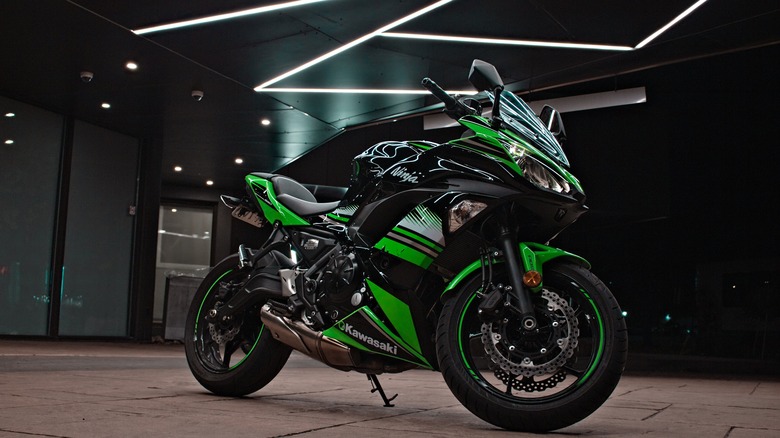
Wirestock/Getty Images
When it comes to iconic motorcycles and producing legends on an assembly line, few brands have made as significant a cultural impact as Kawasaki. From high-octane, high-spec sports bikes to comfortable cruisers, Kawasaki has consistently delivered motorcycles that capture the spirit of two-wheeled transportation. From its humble beginnings in 1986, Kawasaki has evolved into a household name. Even if you’re not a motorcycle enthusiast, you still likely know what a Kawasaki Ninja is.
With sales figures dipping below 500,000 units in 2023, Kawasaki’s latest figures have been less than stellar. That said, the company has made continual, steady progress to raise numbers since the lockdowns during COVID-19 decimated global motorcycle sales. Success is hard won after such a global struggle, but here we’ll be defining success as a combination of performance (racing, specs, speed), sales figures (if available), and cultural/technical impact on motorcycling.
Strap in, because in this article we’ll be taking a look at 10 of the most successful Kawasaki motorcycles in history. From legendary sports bikes like the Ninja H2 to more laidback cruisers like the Vulcan 900, we’ve got successful motorcycles for all walks of life. From beginners in the space to experienced aficionados, this list will be a treat for anyone with oil in their veins and a hankering for the open road.
Kawasaki Ninja H2
The Kawasaki Ninja H2 wasn’t the first in the H-series, but it is the most recognizable. It debuted in 2015, marking a significant leap forward in Kawasaki’s engine design and engineering game that would ripple through their design process. Its success is evidenced by stunning performance and lasting cultural impact.
There are a few models out there at the moment that push past the H2 in terms of power, however, it was somewhat revolutionary when it first hit the streets. It has a 998cc inline four-cylinder engine and produces a mindblowing 200 hp, making it a game-changer in terms of engineering. Its design with a trellis frame and a sleek, aerodynamic body, sets it apart from anything else on the consumer marketplace.
Performance was where the H2 found its glory. It set new benchmarks for sports bikes and was featured across various media, cementing its status as an icon and as a pioneer in its production band. Motorcycle enthusiasts around the world admired it for its cutting-edge engineering and breakneck speed, enshrining its place in pop culture.
The H2’s success didn’t stop with its first release. It continued to evolve, most notably with the later edition Ninja H2R, also featured on this list, a track-only version with over 300 hp. This model, the H2, and its subsequent iterations influenced future Kawasaki bikes, showcasing the company’s commitment to advanced engineering. Even today, the Ninja H2 remains a flagship model.
Kawasaki Ninja ZX-10R
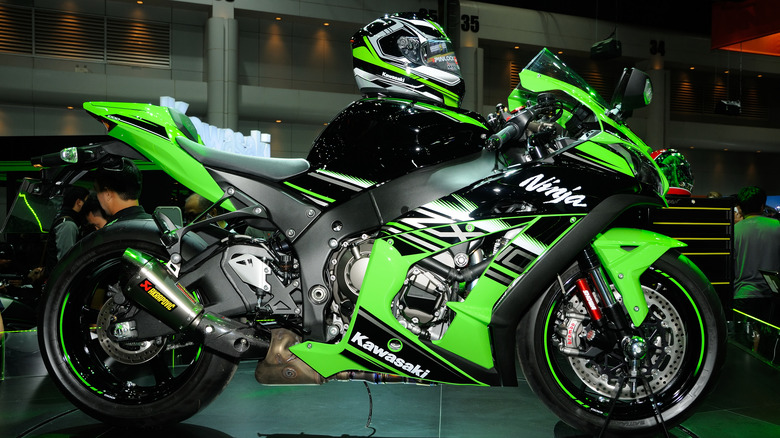
Marukosu/Shutterstock
As the best liter-class superbike on the market, the Kawasaki Ninja ZX-10R is a testament to Kawasaki’s engineering team. It launched in 2004 and has continued to set new benchmarks for what is possible with a production sport bike. It’s designed rather aggressively and is equipped with all the latest tech, which makes this bike perfect for racing and other extreme activities.
Some may say other superbikes are capable of going toe-to-toe with the ZX-10R, but its combination of brute force, agility, and personality are all blue ribbon winners in rider-centricity. It has an inline four-cylinder engine that displaces 998cc and delivers an impressive amount of horsepower to provide neck-snapping acceleration and top speed. The suspension and the body of the ZX-10R are designed to perfection and the bike performs like a weapon on a racetrack, as well as a dream on twisty-turny mountain roads.
The ZX-10R’s domain isn’t limited to racetrack victories— even from a performance standpoint, the Ninja ZX-10R was a resounding success. It seems to be Kawasaki’s engineers’ bottomless bag of tricks, challenging the limits of what is conceivable for street-legal bikes. Some of its characteristics are expressed in elements that filter down to other Kawasaki models, making the entire range more appealing and sporty. To this day, the Ninja ZX-10R is still unchallenged, and it is the perfect example of Kawasaki’s commitment to creating the world’s best sportbike.
Kawasaki Ninja 300
While Kawasaki is no stranger to beginner-friendly motorcycles, the Ninja 300 is an excellent choice for riders who want to get a taste of what motorcycling is all about. First introduced in 2013, the Ninja 300 was quickly heralded as an accessible, easy-to-handle motorcycle for new riders. It is a bike that is easy to break in, light in weight and its power can be easily managed, making it suitable for learner bikers who need to get basic control of a motorcycle down.
Having said that, don’t underestimate it simply because it seems easy to use for a beginner. While it is a lightweight motorcycle, the Ninja 300 doesn’t skimp in power and performance. It has a 296cc engine which provides sufficient oomph for spirited city rides and highway cruising without compromising on fuel economy or ease of usability. The handling of the Ninja 300 is fantastic and the ergonomics are perfect to build the rider’s confidence while maneuvering naturally.
The Ninja 300’s importance isn’t to be pigeonholed as being able to serve as an excellent first bike. The Ninja 300 has led countless people into motorcycling, nurturing the passion for two-wheeled mobility. It’s been a great success for new riders who want to get their feet wet with an affordable, usable, and high-performance motorcycle, the Kawasaki Ninja 300 is a great option—and if the Ninja 300 isn’t your taste, there are plenty of other affordable Kawasaki to choose from.
Kawasaki Z1
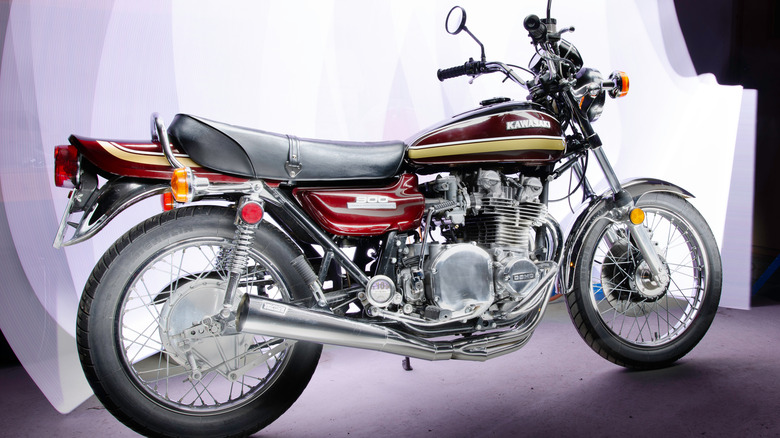
Barbala Obelix/Shutterstock
The Kawasaki Z1 was a symbol of a generation. Launched in 1973, it confounded predictions and rewrote the rulebook for what a production motorcycle could be. This was not your ordinary, run-of-the-mill, non-adventurous drive. The Z1 was a bat out of hell that paved the way for a new generation of high-performance motorcycles—a hellhound that could go beyond 130 mph, something that was considered impossible during the production of the bike.
The Z1’s heart was a 903cc inline four-cylinder engine and left riders astounded with the amount of power it produced. However, it wasn’t just power that was important here. The Z1 blindsided everyone as it was able to handle like a much smaller bike due to the new frame and a suspension system that could handle its power output
The ripples caused by the Z1 were not confined to dealerships and trade shows. As an overwhelming cultural success, it provoked a worldwide passion for strong and fast motorcycles and inspired many a youngster to rebel. The Z1 paved the way for numerous imitations and set a new standard for performance. It was legendary, a true game-changer and a symbol of Kawasaki’s audacity. The Z1’s legacy is set in stone — an icon of an epoch in which motorcycling changed for good.
Kawasaki KX450
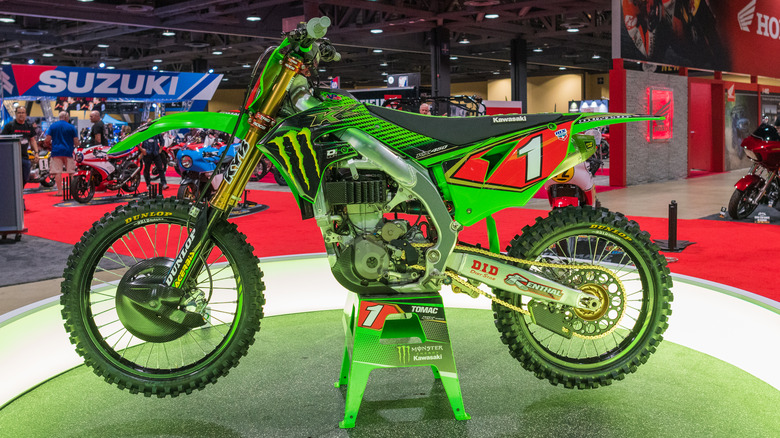
betto rodrigues/Shutterstock
Able to cruise through dirt tracks and leave a striking rooster tail of dust, the Kawasaki KX450 is the definition of a champion bike. This mad motocross machine was first launched in 2006 and it has remained a force on the track ever since. From its reputation on the track to its powerful engine, the KX450 is a force to be reckoned with.
The KX450 is a perfect example of Kawasaki’s dedication to manufacturing machines that dominate the most challenging terrain and outcompete its rivals. Its 449cc engine is a masterpiece of off-road engineering, a thumping pulse of power that pushes riders to the edge, and an utter performance success story.
But power is only one facet of this absolute gem of a bike. The KX450 is made out of ultra-lightweight aluminum and has out-of-this-world handling that enables riders to overcome any course they challenge. Its suspension system is one of the best in the business, absorbing impacts and managing to provide a very stable ride, which keeps the riders’ eyes on the prize – that checkered flag.
Kawasaki doesn’t miss any chance to bring out the best of the KX450, which is one of the many reasons why so many riders go for this bike to achieve top performance and that much-desired podium finish. The KX450 is a top choice for motocross riders looking to become legends in their own right.
Kawasaki Vulcan 900
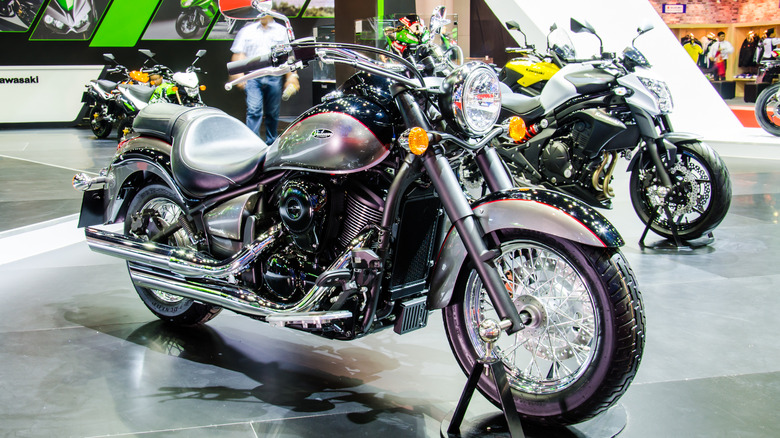
Chatchai Somwat/Shutterstock
The Kawasaki Vulcan 900 is a laid-back cruiser with attitude. It was launched in 2006 and almost immediately gained popularity for its comfort and stylish design, perfect for a weekend or a getaway ride on the scenic route.
Picture this: you’re riding along a coastal road, the wind whipping around your head and the heady thrumming purr of the Vulcan 900’s 903cc engine pulsating to the beat of the road. This isn’t a bike designed to go the fastest, it’s there for the thrill and enjoyment of motorcycling, all about the journey, not the destination.
The Vulcan 900 boasts a timeless cruiser design with classic lines, a teardrop fuel tank, and chrome accents. Its aesthetic appeal attracts riders looking for a bike with a traditional appearance. The Vulcan 900’s ergonomic design also makes it an absolute dream to cruise along in, letting you sit back, relax, and dominate miles of asphalt.
The Vulcan 900 is a motorcycle that isn’t for everyone — it’s designed with a very specific type of rider in mind. The ideal rider for this model is someone who prefers a leisurely stroll over a brisk jog or even a hard-hitting run. It found its success in this niche as a nostalgic icon. It showed its true colors as a rival in the cruiser circuit and offered style and comfort that few others could match.
Kawasaki Versys 650
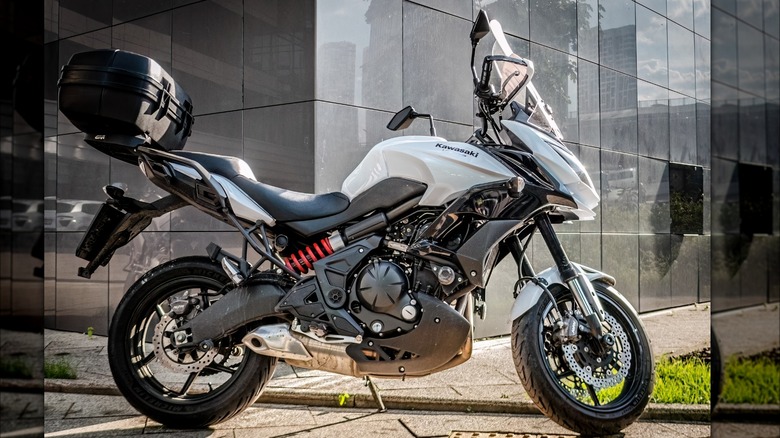
Haggardous50000/Shutterstock
Check your notions of a one-trick motorcycle at the door. Kawasaki introduced the Versys 650 in 2009 and it’s a two-wheeled wonder that transforms to fit your desire. It is your bike for daily rides in the city, a master of zig-zagging backcountry roads, and a reliable conveyance for going off the asphalt. Not to mention it’s totally affordable, like many other Kawasaki motorcycles.
The Versys’ versatility starts with its heart: a reliable 650cc parallel-twin engine. It provides consistent and steady power—ideal for weaving through urban passes or putting in high mileage on interstates. The riding posture is correct for sightseeing and less fatigue since you’re not hunched over the handlebars. It’s a true touring bike because of its wind protection and ergonomic design, but it’s also lightweight and easy to manage for a beginner, leading to its success as a versatile everyman’s bike.
With that in mind, the Versys’ allure doesn’t stop at its engine and comfort. It has features of both adventure and sport touring bikes and can take you through gravel roads with just as much ease as it can conquer highways. Whether you’re stuck in traffic during rush hour, taking a weekend excursion, or carving your own path, the Versys 650 is up for anything. This is a perfect example of Kawasaki’s skills in designing an all-around and powerful bike: a ticket to a wide and exciting world on a path of your own making.
Kawasaki H2R
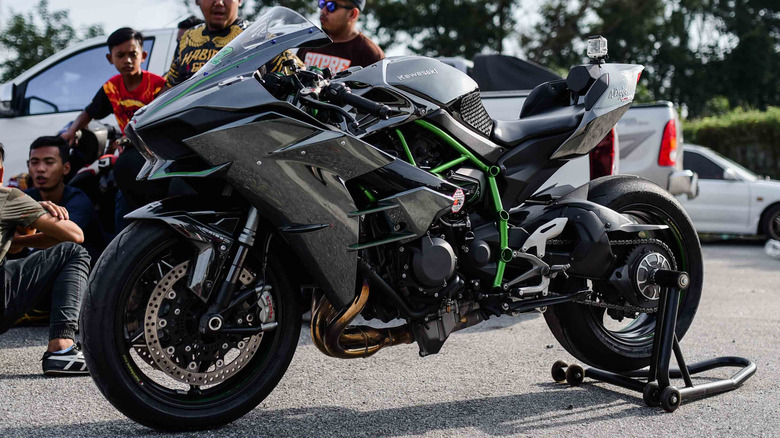
Muhammad Afiq artz/Shutterstock
Few performance success stories are as compelling as the one that began in 2016 in the form of the Kawasaki Ninja H2R. No more streets, no more speed limits; this track-only monster was a force to be reckoned with, a statement of aggressive power and engineering innovation, a bike that tore through conventions and redefined what it meant to be a production motorcycle.
Suspended on a very rigid cradle-like chassis sits a 998cc supercharged four-cylinder engine, a technological wonder that churns out more than 300 horsepower. This is not just stunning; it takes the H2R to ridiculous speeds, a bike that could well be the fastest production motorcycle in the world. However, the H2R isn’t a one-trick pony. Its body design is sleeker than a lightning bolt. It has a radical ram-air intake and aggressive wings to generate downforce that anchors the machine like a predator even at high speeds.
The H2R is not just about faster lap times though. This is a good example of Kawasaki’s unrelenting effort to advance the technological spirit of motorcycles. As a worthy addition to Kawasaki’s extensive lineup of expert bikes, it was a proving ground for concepts that were later introduced in their other production models — models that can be used on public roads. The H2R is not just a motorcycle, it is Kawasaki’s ambition incarnate, a look into the future of sport motorcycles, and a wild, powerful animal let loose on the racetrack.
Kawasaki W800
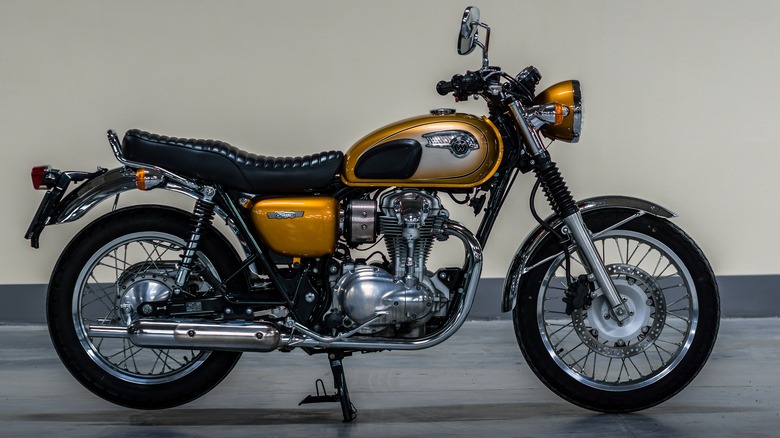
rebinworkshop/Shutterstock
Let’s not let the crazy agility of today’s motorcycles go uncontested. Kawasaki introduced the W800 in 2011 — a two-wheeled time machine that takes riders back to the good old days of motorcycling. This isn’t a machine that’s pursuing horsepower or lap time; it’s celebrating leisure and the freedom of the asphalt.
The W800 is not tricked out with high-tech features or aggressive bodywork. It has a purer nature at its core, leaving the highlight where it belongs: on the ride. The W800’s heart is a pulsating, air-cooled 773cc V-twin engine. It may not have overwhelming power but it does have a beat that is in harmony with the bike’s laid-back persona. The neutral posture and the upright ergonomic design make cruising as comfortable as a dream, whether it’s on beautiful country roads or a Sunday morning ride.
The W800 isn’t just an old-school showpiece with a classic design approach. It could be on a list of the most eye-catching motorcycles in history. The design was a huge success with its timelessness. The W800 is chrome-decorated with a teardrop-shaped fuel tank that makes the rider feel like they are riding back in the 1960s. It’s ideal for experienced bikers who want to ride without all the complicated features or beginners who are fascinated by the design. The W800 is a link between motorcycling tradition and today’s engineering, which is evidence of Kawasaki’s capacity to establish a bike that represents the spirit of motorcycling.
Kawasaki H1 Mach III
By the time that riding was old hat, and Harley-Davidson was becoming old news, the motorcycle cityscape was as recognizable as New York’s own. Riders demanded something more, and Kawasaki’s answer was the H1 Mach III. It was a screaming success of specifications and culture from the moment it debuted in 1969 and rewrote the rulebook on performance.
Forget the mild two-stroke models of yesteryear; the H1 was a hot tamale with 498 beautiful cubic centimeters of three-cylinder beauty. The H1 was the first production motorcycle to top 200 km/h, which led to its legendary nickname, the Mach III. This was not just any motorcycle; it was a message from Hermes himself, an unapologetic bolt of chrome that left motorcyclists gasping.
The H1’s impact wasn’t confined to the racetrack. It transcended the world of motorcycling, becoming a cultural phenomenon. Featured in movies and mass media, the H1 captured the imagination of a generation. It wasn’t just about speed; it was about the spirit of rebellion, a raw and exhilarating experience that redefined the superbike.
Sure, the H1 wasn’t for the faint of heart, but it still holds its own against the best Kawasaki motorcycles ever made. Its power demanded respect, and its handling required a firm grip. But for those who dared to tame it, the H1 offered an unforgettable ride. It was a game-changer, a legend forged in speed, and a testament to Kawasaki’s spirit.